Text
They're called dicynodont-like reptiles, so theriodonts would make the most sense :p
mammals man. mammals. I apologize I'm not a synapsid researcher so stuff might be wrong/outdated.
176 notes
·
View notes
Text
Hibbertopterids lasted until the late Permian, so there's that!

Inostranscevia hunting Campylocephalus, by TrollMans
A Prologue to Amniotes
Part IV - The egg came first
Late Mississippian. It has been 40 million years since tetrapods first walked on land. Every generation since then, they have remained bound to the waters for at least one moment in their life cycle.
Despite their adaptations for walking on land, early tetrapod reproduction wasn't much different from that of their fish predecessors. Spawning, or external fertilization of an egg mass, with eggs covered in a gelatinous membrane laid in a body of water, prevending the permeable eggs from dessicating.
But things are now changing. While the mid-Carboniferous rainforests still provide safe, moist environments, reptiliomorphs have already begun adventuring further inland. As swamps left room to humid crevices to lay eggs in, creatures like Casineria also began to develop internal fertilization, refusing to leave their reproduction at the mercy of the elements.
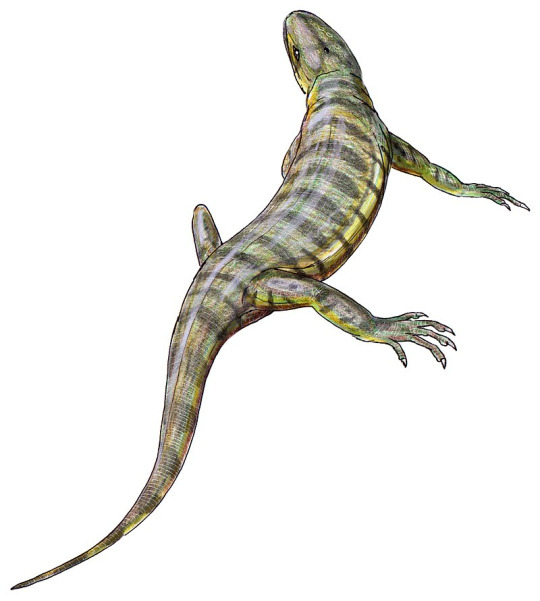
Casineria kiddi, an early amniote relative by ДиБгд (CC-BY-SA 4.0)
Adventuring into even drier environments, ancestors of amniotes still had to solve two crucial problems. While a harder shell could prevent the egg from dessicating, it would doom the embryo to suffocation, by preventing it to get rid of carbon dioxide. Furthermore, the small size of the eggs - also constrained by gas exchange - limited the full development of the embryo before hatching.
To solve both of these issues, the outer layers of the eggs would have to be reshaped. The outer gelatinous layer was replaced by a fibrous membrane for protection, and later by the three layers known as extraembryonic membranes: the amnion, chorion and allantois. The innermost amnion would surround and protect the embryo, while the outer chorion and sac-like allantois take care of gas exchange and waste removal.
In the safety of the amniotic egg, the embryo was able to hatch considerably more developed than before. Skipping the larval stage, amniote youngs would hatch as miniatures of the adults, making them able to face the challenges of the Carboniferous world from the day of their birth.

Structure of the amniotic egg, by Lumen Learning (CC-BY)
As the Pennsylvanian began and climate started to dry out, later developments would perfect the ability of early amniotes to survive in drier, fully terrestrial environments. A thicker, less permeable skin will develop, incorporating keratin and preventing dessication. Cutaneous respiration, requiring the skin to be moist at all times, will give way to costal respiration, harnessing the power of the ribcage to expand and contract the lungs. Cutting their last ties with the water, amniotes had finally conquered the land.
On one fateful day, not long after the amniote body plan was perfected, one of the most decisive splits in vertebrate history would occur. A divergence of the amniotes into two major lineages, alternating domination of land, sea and sky for the next 320 million years. But sauropsids like Hylonomus would at first stay in the shadows. The stage of the Late Pennsylvanian would be left to their rivals and cousins, as forerunners like Archaeothyris paved the way for their own lineage: the synapsids.
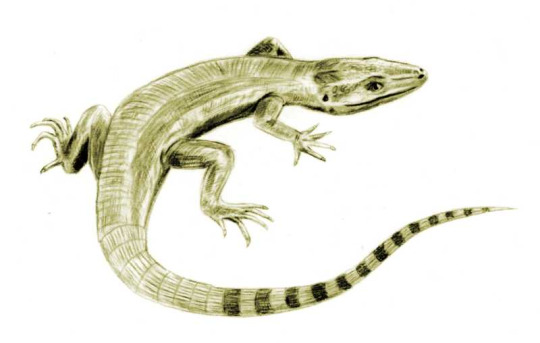
Archaeothyris, one of the first known synapsids, by ArthurWeasley (CC BY-SA 3.0)
15 notes
·
View notes
Text
A Prologue to Amniotes
Part IV - The egg came first
Late Mississippian. It has been 40 million years since tetrapods first walked on land. Every generation since then, they have remained bound to the waters for at least one moment in their life cycle.
Despite their adaptations for walking on land, early tetrapod reproduction wasn't much different from that of their fish predecessors. Spawning, or external fertilization of an egg mass, with eggs covered in a gelatinous membrane laid in a body of water, prevending the permeable eggs from dessicating.
But things are now changing. While the mid-Carboniferous rainforests still provide safe, moist environments, reptiliomorphs have already begun adventuring further inland. As swamps left room to humid crevices to lay eggs in, creatures like Casineria also began to develop internal fertilization, refusing to leave their reproduction at the mercy of the elements.

Casineria kiddi, an early amniote relative by ДиБгд (CC-BY-SA 4.0)
Adventuring into even drier environments, ancestors of amniotes still had to solve two crucial problems. While a harder shell could prevent the egg from dessicating, it would doom the embryo to suffocation, by preventing it to get rid of carbon dioxide. Furthermore, the small size of the eggs - also constrained by gas exchange - limited the full development of the embryo before hatching.
To solve both of these issues, the outer layers of the eggs would have to be reshaped. The outer gelatinous layer was replaced by a fibrous membrane for protection, and later by the three layers known as extraembryonic membranes: the amnion, chorion and allantois. The innermost amnion would surround and protect the embryo, while the outer chorion and sac-like allantois take care of gas exchange and waste removal.
In the safety of the amniotic egg, the embryo was able to hatch considerably more developed than before. Skipping the larval stage, amniote youngs would hatch as miniatures of the adults, making them able to face the challenges of the Carboniferous world from the day of their birth.

Structure of the amniotic egg, by Lumen Learning (CC-BY)
As the Pennsylvanian began and climate started to dry out, later developments would perfect the ability of early amniotes to survive in drier, fully terrestrial environments. A thicker, less permeable skin will develop, incorporating keratin and preventing dessication. Cutaneous respiration, requiring the skin to be moist at all times, will give way to costal respiration, harnessing the power of the ribcage to expand and contract the lungs. Cutting their last ties with the water, amniotes had finally conquered the land.
On one fateful day, not long after the amniote body plan was perfected, one of the most decisive splits in vertebrate history would occur. A divergence of the amniotes into two major lineages, alternating domination of land, sea and sky for the next 320 million years. But sauropsids like Hylonomus would at first stay in the shadows. The stage of the Late Pennsylvanian would be left to their rivals and cousins, as forerunners like Archaeothyris paved the way for their own lineage: the synapsids.

Archaeothyris, one of the first known synapsids, by ArthurWeasley (CC BY-SA 3.0)
15 notes
·
View notes
Text
Got the idea of making polls from @a-dinosaur-a-day, I might do a few of them before/between writing blog entries!
I'm wondering where everyone stands between avoiding mammal bias on one side, and highlighting the connections between synapsids and mammals on the other!
90 notes
·
View notes
Text
It was actually believed to be the ancestor of caecilians for some time, related to Eocaecilia, although it later turned out to be convergent evolution!

Eocaecilia, an actual caeciliancestor, by Nobu Tamura (CC-BY 3.0)
A Prologue to Amniotes
Part III - The “Age of Amphibians”
A long time has passed since my previous blog post. Two months, or around twenty million years, depending on how you count.
We are now in the middle of the Carboniferous (late Mississippian for the Americans out there). Stegocephalians are out of fashion, new models of amphibians have been released. They’re actually able to spend most of their time on land! (well, a few went back to the water, but still)
Unfortunately, there’s no real word for this faunal shift. An interesting concept that we can use, however, is the one of megadynasty. They’re basically evolutionary faunas but on land, an idea introduced by Brenchley and Harper in 1998. Basically, Megadynasty I corresponds to the amphibians and pelycosaurians, Megadynasty II is the therapsids, and Megadynasty III is the dinosaurs. You can quickly see how this is more than approximative, as I doubt Ichthyostega and Dimetrodon have much in common to justify this grouping. Oh, and they forgot the entire Cenozoic.
A better system would be to have a “Megadynasty 0″ corresponding to the stegocephalians (when the “going on land” functionality was still in beta), with I for the later amphibians and II for the pelycosaurians. Here’s a schema:

Seven-megadynasty paradigm, by Quark-Nova (CC-SA 3.0)
Are the amphibians really the only ones to dominate the ecosystem? Certainly not - giant insects and arthropods would certainly like to have a word with them. And, quite honestly, a two-meter long Arthropleura or a 350 kilogram Hibbertopterus would probably win an argument against me on intimidation alone. But, unfortunately for them, I’m still alive and they aren’t - fact is, amphibians and their descendants ultimately did a better job at shaping the megafauna. Which is why the goal of this blog is to talk about synapsid evolution, rather than giant insect evolution.
But what was the Carboniferous like exactly? Popular conception pictures it as a mostly uniform “rainforest” of giant fern trees. And, while it’s not completely wrong, something is quite often left out of the picture. The Middle Carboniferous saw the beginning of the Karoo ice age, an icehouse world that would last until the Permian and see large ice sheets cover much of the planet. But the ice age wasn’t at its peak yet, and amphibians could comfortably chill in the rainforest. For now, at least.
So, what were they doing? Quite a lot, actually. A lot of them decided that becoming l o n g was the way to go, with adelospondyls, aistopods and various other groups ranging in body plans from reptilian ferret to actual snake.

Rhynchonkos, a ferret microsaur, by Smokeybjb (CC-SA 3.0)
A lot of these groups were historically classified as “lepospondyls”, with everyone’s favourite boomerang-headed Diplocaulus, although early tetrapod classification is conspicuously inconsistent - Rhynchonkos up there might actually be an early reptile! Lepospondyls themselves might be more related to amniotes, to modern amphibians, or away from the branch leading to both entirely.
Another group that dominated the middle Carboniferous, temnospondyls, are more well-grounded - both phylogenetically and in terms of their terrestrial lifestyle. The likely ancestors of modern frogs and salamanders, a lot of them were ironically way less reliant on water, with scales allowing them to retain humidity more efficiently (modern amphibians are smooth). They also had way more game impact than their descendants, with even early forms like Capetus reaching a meter and a half, and being more crocodile-like in appearance.

Capetus, an early temnospondyl, by Dmitry Bogdanov (CC-SA 3.0)
Unfortunately, a design flaw still remained, as their eggs and babies still needed water to develop in. Although some temnospondyls had an innovative solution: laying their eggs in humid crevices, allowing them to reproduce even far away from actual bodies of water!
Another group was on the rise, concurrently with temnospondyls. Reptiliomorphs are often discussed as major players in the middle Carboniferous fauna, although this word hides a lot of complexity under the hood. In fact, any creature closer to amniotes than to modern amphibians is classified as a “reptiliomorph” - even possibly lepospondyls. Really, the trend of gradual independence from water wasn’t a linear path, but several groups trying out innovations concurrently. Internal fertilization, direct development (skipping the problematic tadpole stage), and ultimately, one that would revolutionize life on land: the amniotic egg.
19 notes
·
View notes
Text
A Prologue to Amniotes
Part III - The “Age of Amphibians”
A long time has passed since my previous blog post. Two months, or around twenty million years, depending on how you count.
We are now in the middle of the Carboniferous (late Mississippian for the Americans out there). Stegocephalians are out of fashion, new models of amphibians have been released. They’re actually able to spend most of their time on land! (well, a few went back to the water, but still)
Unfortunately, there’s no real word for this faunal shift. An interesting concept that we can use, however, is the one of megadynasty. They’re basically evolutionary faunas but on land, an idea introduced by Brenchley and Harper in 1998. Basically, Megadynasty I corresponds to the amphibians and pelycosaurians, Megadynasty II is the therapsids, and Megadynasty III is the dinosaurs. You can quickly see how this is more than approximative, as I doubt Ichthyostega and Dimetrodon have much in common to justify this grouping. Oh, and they forgot the entire Cenozoic.
A better system would be to have a “Megadynasty 0″ corresponding to the stegocephalians (when the “going on land” functionality was still in beta), with I for the later amphibians and II for the pelycosaurians. Here’s a schema:

Seven-megadynasty paradigm, by Quark-Nova (CC-SA 3.0)
Are the amphibians really the only ones to dominate the ecosystem? Certainly not - giant insects and arthropods would certainly like to have a word with them. And, quite honestly, a two-meter long Arthropleura or a 350 kilogram Hibbertopterus would probably win an argument against me on intimidation alone. But, unfortunately for them, I’m still alive and they aren’t - fact is, amphibians and their descendants ultimately did a better job at shaping the megafauna. Which is why the goal of this blog is to talk about synapsid evolution, rather than giant insect evolution.
But what was the Carboniferous like exactly? Popular conception pictures it as a mostly uniform “rainforest” of giant fern trees. And, while it’s not completely wrong, something is quite often left out of the picture. The Middle Carboniferous saw the beginning of the Karoo ice age, an icehouse world that would last until the Permian and see large ice sheets cover much of the planet. But the ice age wasn’t at its peak yet, and amphibians could comfortably chill in the rainforest. For now, at least.
So, what were they doing? Quite a lot, actually. A lot of them decided that becoming l o n g was the way to go, with adelospondyls, aistopods and various other groups ranging in body plans from reptilian ferret to actual snake.

Rhynchonkos, a ferret microsaur, by Smokeybjb (CC-SA 3.0)
A lot of these groups were historically classified as “lepospondyls”, with everyone’s favourite boomerang-headed Diplocaulus, although early tetrapod classification is conspicuously inconsistent - Rhynchonkos up there might actually be an early reptile! Lepospondyls themselves might be more related to amniotes, to modern amphibians, or away from the branch leading to both entirely.
Another group that dominated the middle Carboniferous, temnospondyls, are more well-grounded - both phylogenetically and in terms of their terrestrial lifestyle. The likely ancestors of modern frogs and salamanders, a lot of them were ironically way less reliant on water, with scales allowing them to retain humidity more efficiently (modern amphibians are smooth). They also had way more game impact than their descendants, with even early forms like Capetus reaching a meter and a half, and being more crocodile-like in appearance.

Capetus, an early temnospondyl, by Dmitry Bogdanov (CC-SA 3.0)
Unfortunately, a design flaw still remained, as their eggs and babies still needed water to develop in. Although some temnospondyls had an innovative solution: laying their eggs in humid crevices, allowing them to reproduce even far away from actual bodies of water!
Another group was on the rise, concurrently with temnospondyls. Reptiliomorphs are often discussed as major players in the middle Carboniferous fauna, although this word hides a lot of complexity under the hood. In fact, any creature closer to amniotes than to modern amphibians is classified as a “reptiliomorph” - even possibly lepospondyls. Really, the trend of gradual independence from water wasn’t a linear path, but several groups trying out innovations concurrently. Internal fertilization, direct development (skipping the problematic tadpole stage), and ultimately, one that would revolutionize life on land: the amniotic egg.
#a prologue to amniotes#palaeoblr#carboniferous#mississippian#pennsylvanian#serpukhovian#lepospondyli#temnospondyli#reptiliomorpha
19 notes
·
View notes
Text
A Prologue to Amniotes
Part II - Bridging the gap
We left our early tetrapods in the wake of one of the most disastrous mass extinctions ever. Unfortunately, they all died.
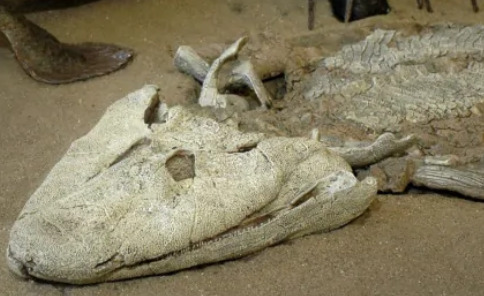
Tiktaalik, not in its greatest shape today (University of Chicago/Beth Rooney/Associated Press)
Well, not all of them. But that’s definitely what the fossil record would have you believe. We have entered the Carboniferous period (Mississippian for the Americans out here), and, with it, the enigmatic Romer’s gap.
This gap didn’t only affect early tetrapods. In the wake of the late-Devonian extinction, we find a 20 million year long stretch of Carboniferous with extremely few fossils, leaving a gap in our understanding of the crucial Devonian-Carboniferous transition - and of early tetrapod evolution.
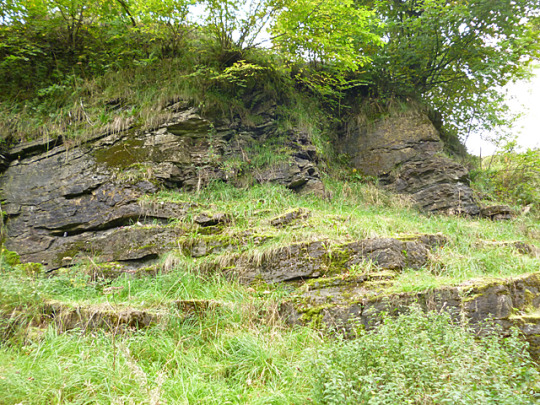
West Lothian, Scotland, source of many early Carboniferous fossils and British parliamentary questions (Anne Burgess, CC-BY-SA 2.0)
Could this gap simply be an artifact? It is definitely possible that the conditions in the early Carboniferous weren’t especially conductive to fossilization, and a few fossils have in fact been found from the gap itself!
However, it appears that this gap corresponded to a genuine point of low diversity. Oxygen levels were critically low at the time (by Carboniferous standards, so a little under modern-day level), causing a decline in diversity in both tetrapods and terrestrial arthropods. Which would have quite an interesting consequence for their conquest of land, with both evolving in relative obscurity ahead of a future radiation.

Crassigyrinus, an early aquatic tetrapod from the Romer Gap of Scotland (Nobu Tamura, CC BY-SA 3.0)
As we saw last time, the first “stegocephalian”-grade tetrapods weren’t really terrestrial at all. And, while a few of them would be found in the waters of Romer’s gap itself (like the fully aquatic Crassigyrinus, pictured above), they would leave the next generation of tetrapods to make its debuts on land, with strong, forward-facing limbs fully adapted to life on land.
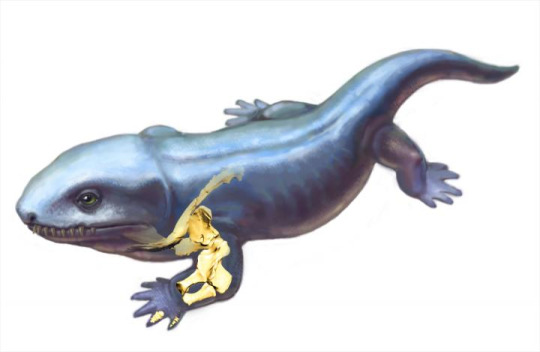
Life reconstruction of the early tetrapod Pederpes showing the forelimb bones beneath the skin (Julia Molnar, Copyright 2021)
The best embodiment of this transition is undoubtably Pederpes. Another of the rare Romer’s gap finds, this “amphibian” still had the characteristic many-fingered limbs of their stegocephalian ancestors, while already showing signs of the transition towards pentadactyly - the sixth digit wasn’t weight-bearing at all. Interestingly, its post-Romer relatives like Whatcheeria would be fully pentadactylous - converging with the condition found in modern tetrapods.
These forerunners would coexist with more derived tetrapods, whose soon to be dominant lineages made their obscure debuts during the gap. It is during this time that the ancestors of modern-day amphibians and amniotes - respectively, temnospondyls like Balanerpeton and reptiliomorphs like Eldeceeon - would diverge, and become mostly or fully terrestrial. Along with a third enigmatic group, the lepospondyls, they would come to define the ecosystems of the middle Carboniferous…
8 notes
·
View notes
Text
A Prologue to Amniotes
Part I - A fish out of water
So you see, that’s where the trouble began.
That fish.

That damn fish.
Tiktaalik was an elpistostegalian, or “fishapod”. Combining ancestral fish-like characteristics with more modern adaptations, it was among the first vertebrates to walk on land.
Of course, the transition from water to land didn’t happen in one go. Even after Tiktaalik, the first true tetrapods - or four-limbed vertebrates - weren’t close to being fully terrestrial, and most of them only occasionally ventured on land.

Ichthyostega skeletal reconstruction, E. Ahlberg (2018)
In fact, most of the characteristics that led tetrapods onto land were repurposed adaptations - or exaptations, as we call them. Tiktaalik, Ichthyostega and kin lived mostly in shallow swamps, where limbs were more effective than fins for navigating through the obstacles.
These proto-limbs weren’t yet enough to walk, and Ichthyostega would be more likely to drag its body, pushing it forward with its limbs like a mudskipper.
But, at the time, this might have been enough. Giant lobe-finned fish like Hyneria, relatives of our tetrapod ancestors, hunted in the shallows. As they could beach themselves on land like a modern-day orca to catch prey, being able to crawl a few more meters could mean the difference between life and death.

Hyneria attacking a Hynerpeton, Walking with Monsters (2005)
Unfortunately, the heyday of these first tetrapods would quickly come to an end. Two pulses of a devastating mass extinction would close the Devonian period, concluding this first experiment and bringing tetrapods into obscurity for millions of years to come…
29 notes
·
View notes